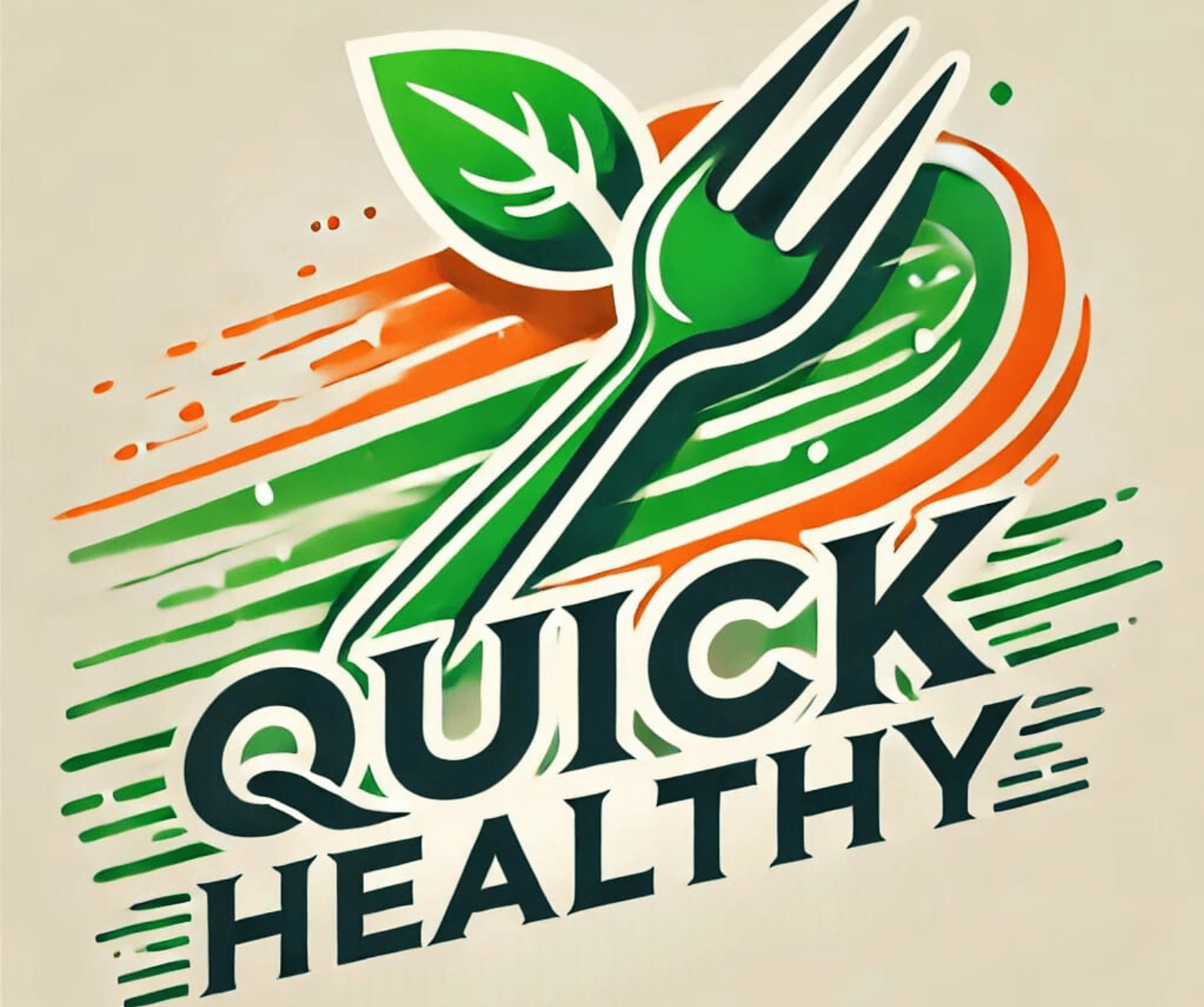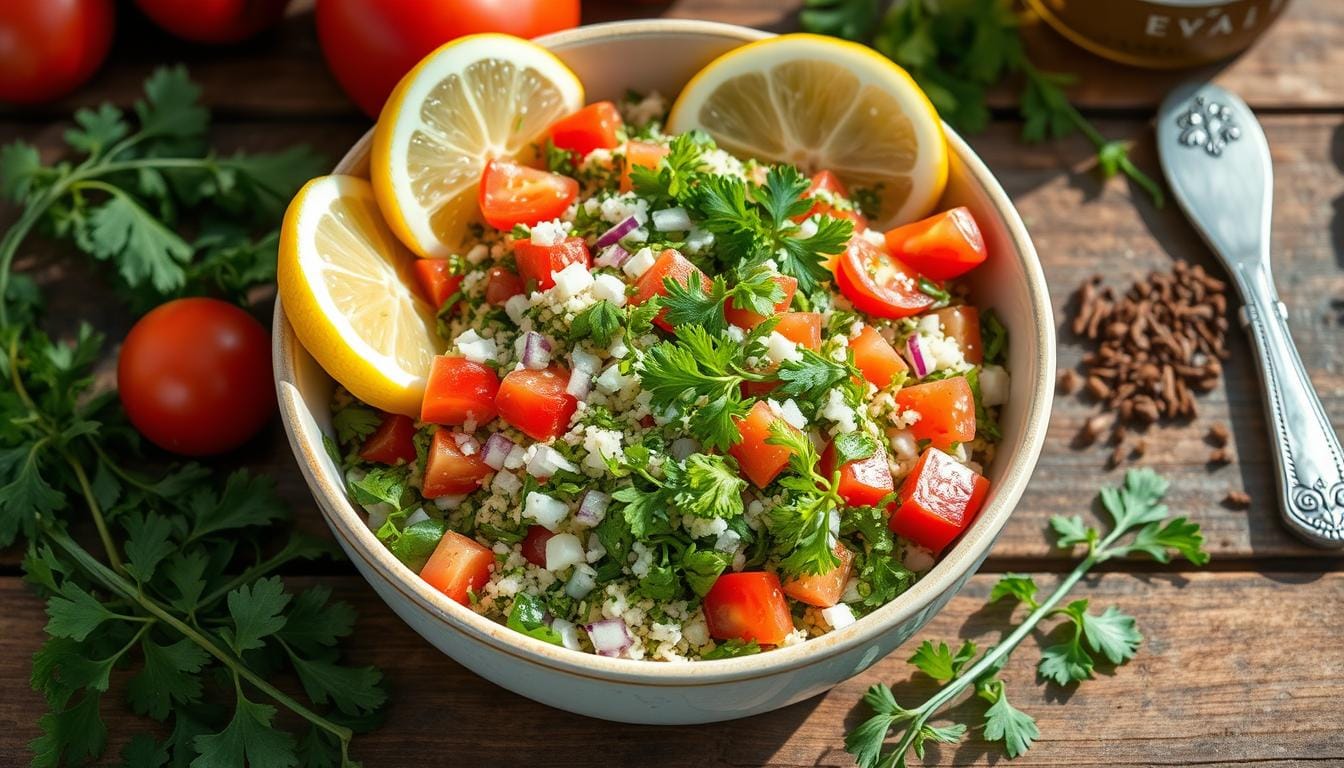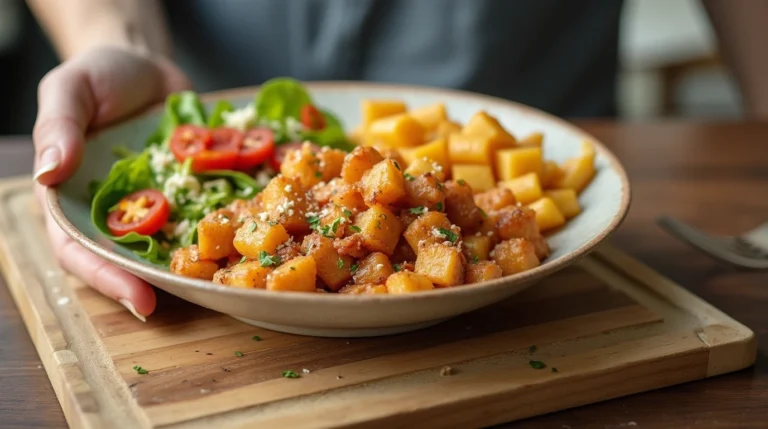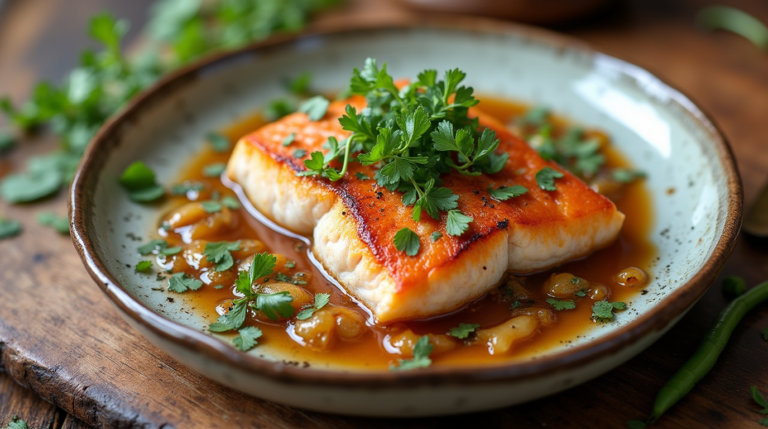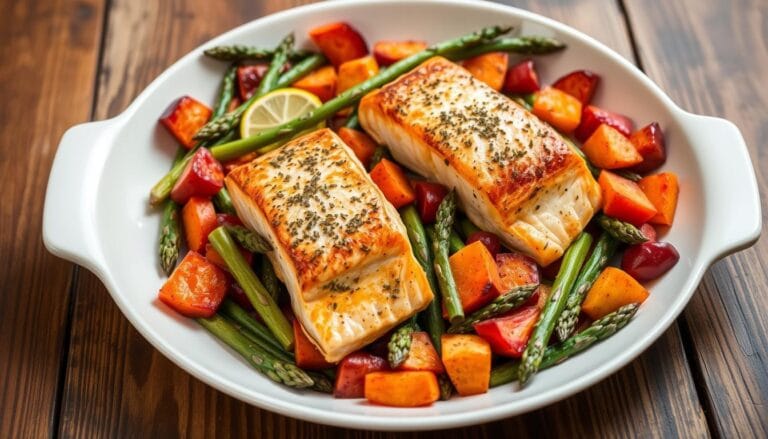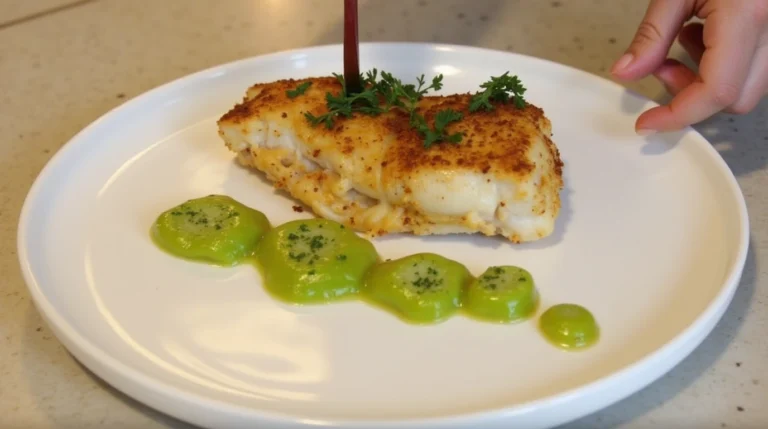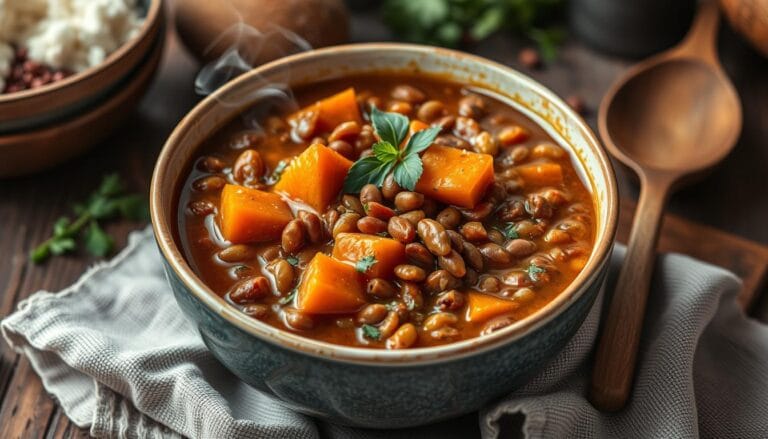Best Lebanese Tabouleh Salad: A Refreshing Starter
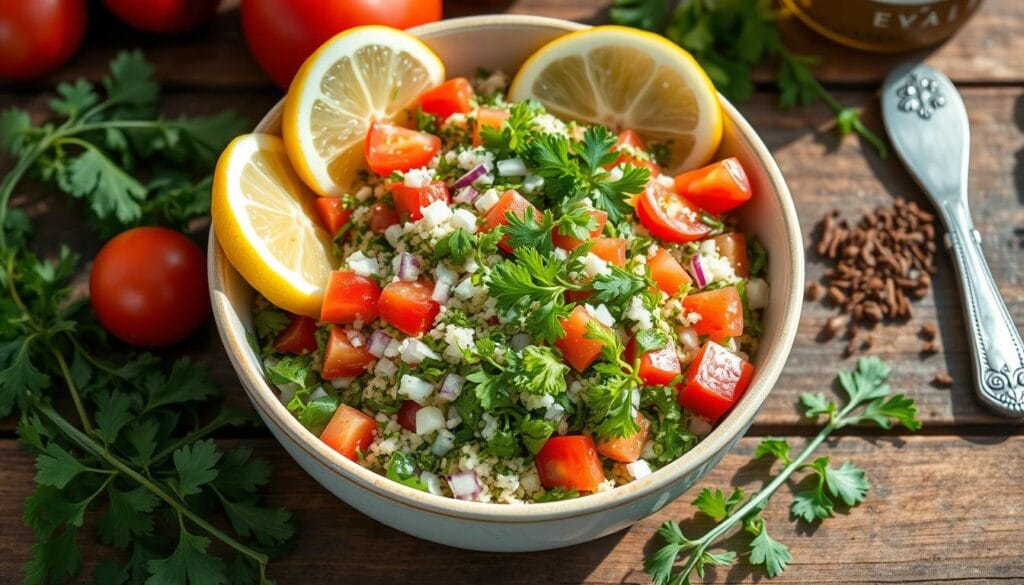
Table of Contents
Lebanese Tabouleh Salad: A Refreshing Starter
The first time I tasted authentic Lebanese tabouleh, it was like discovering a culinary symphony. My grandmother’s friend from Beirut had prepared this vibrant Mediterranean starter. It changed my view of salads forever.
The bright green mosaic of fresh parsley, the delicate bulgur wheat, and the zesty lemon dressing created a lunch and dinner delight. It spoke directly to my soul.
Tabouleh isn’t just a salad—it’s a celebration of fresh ingredients and cultural heritage. This fresh parsley salad represents more than a simple side dish. It embodies the rich culinary traditions of Lebanon, bringing together simple ingredients that create an extraordinary sensory experience.
When you explore tabouleh, you’re diving into a world of nutrition, flavor, and tradition. Each bite tells a story of Mediterranean food culture. It invites you to experience a dish that has traveled generations and continents.
What Makes Lebanese Tabouleh a Mediterranean Masterpiece
Lebanese tabouleh is a vibrant symbol of Mediterranean cuisine’s rich heritage. It’s more than a salad; it’s a cultural expression that embodies Lebanese food culture. Every bite is a burst of freshness and zest.
Exploring tabouleh takes you on a journey through tradition and flavor. It’s deeply rooted in Lebanese culinary history. It’s not just a dish; it’s a symbol of hospitality and community.
Origins and Cultural Significance
Tabouleh comes from Lebanon’s mountainous regions. It started as a peasant dish, celebrating fresh, local ingredients. It reflects the Middle East’s agricultural traditions, where every herb and grain has a story.
- Originated in Mount Lebanon region
- Represents peasant cooking traditions
- Symbolizes community and shared meals
Traditional Role in Lebanese Cuisine
In Lebanese homes, tabouleh is a key dish. It’s often part of mezze, a spread of small dishes for sharing. It brings people together, showing the warmth of Lebanese hospitality.
“Tabouleh is not just a salad, it’s a conversation starter at our family table.” – Lebanese Food Historian
Regional Variations Across the Middle East
While Lebanon is tabouleh’s birthplace, other countries have made it their own. Each adds its own twist, showing the lively nature of Middle Eastern salads and traditions.
- Syria: Uses more bulgur wheat
- Palestine: Incorporates additional spices
- Jordan: Adds unique herb combinations
Essential Ingredients for Authentic Tabouleh
To make authentic Lebanese Tabouleh, start with the freshest herbs and best ingredients. The quality of each part you pick is key to a great Tabouleh.
Traditional Tabouleh is all about a few fresh herbs and simple items. These mix to make a lively, tangy salad. Let’s look at the main ingredients that make this dish special.
- Parsley: The star of the dish, fresh flat-leaf parsley must be crisp and bright green
- Mint leaves for a refreshing aromatic touch
- Ripe, firm tomatoes
- Finely chopped white or red onions
- Fine bulgur wheat
The secret to a true Lebanese recipe is in how you mix and prepare these ingredients. Make sure to chop your herbs gently, so they stay light and fluffy.
| Ingredient | Quantity | Role in Dish |
|---|---|---|
| Parsley | 2 bunches | Primary flavor and texture |
| Mint | 1/2 bunch | Aromatic freshness |
| Tomatoes | 2-3 medium | Moisture and sweetness |
| Onion | 1 small | Sharp flavor accent |
| Bulgur Wheat | 1/4 cup | Texture and substance |
“In Lebanese cuisine, fresh herbs are not just ingredients—they are the soul of the dish.” – Lebanese Culinary Tradition
Using top-notch, fresh herbs will make your Tabouleh a true Mediterranean gem. Each part is crucial for the perfect flavor mix that makes this dish so loved.
The Perfect Parsley: Selecting and Preparing Your Greens
Parsley is key to a great Tabouleh salad. The right parsley can turn a simple dish into a masterpiece. Fresh parsley adds a burst of flavor and texture.
Choosing the right parsley is important for Tabouleh’s texture. Not all herbs are the same. The right one can make your dish stand out.
Flat-Leaf vs. Curly Parsley: The Great Debate
- Flat-leaf parsley (Italian parsley) has a stronger, cleaner taste
- Curly parsley tastes milder and looks good on salads
- Recommendation: Flat-leaf parsley is best for real Tabouleh
Washing and Drying Techniques
Cleaning your parsley right is the first step. Here’s how to keep it fresh:
- Rinse parsley under cold water
- Shake it gently to get rid of water
- Pat dry with a clean towel
- Let it air dry for 15-20 minutes
Chopping for Optimal Texture
| Chopping Method | Texture Result | Recommended Use |
|---|---|---|
| Fine Chop | Delicate, uniform | Traditional Tabouleh |
| Rough Chop | Rustic, chunky | Casual, home-style presentation |
“The key to great Tabouleh lies in the parsley’s preparation. Treat it with respect, and it will reward you with incredible flavor.” – Mediterranean Chef
Learn these steps, and your Tabouleh will be a hit. Your guests will love the fresh, authentic herb salad.
Bulgur Wheat: The Heart of Tabouleh
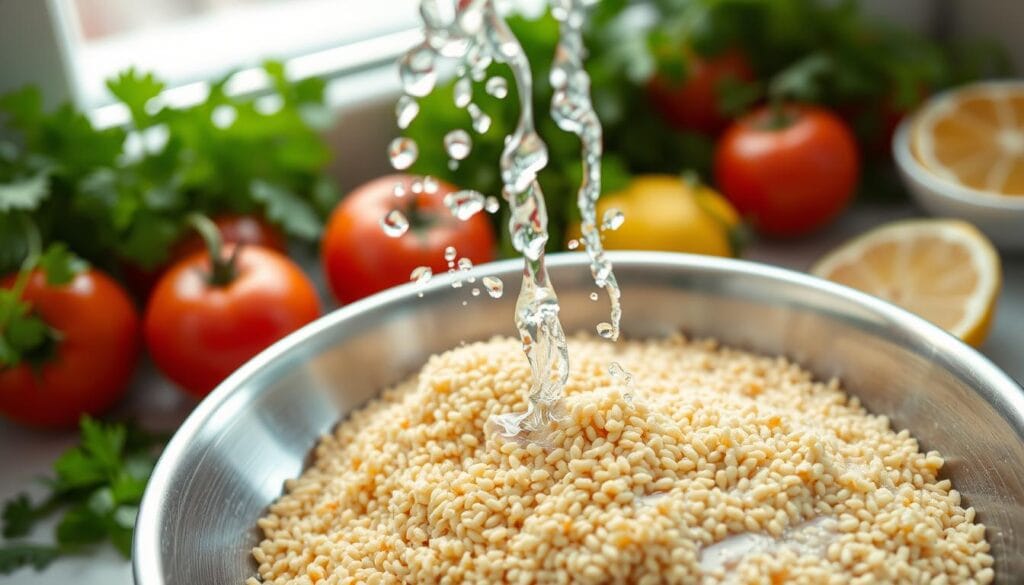
Bulgur wheat is the key ingredient that makes Tabouleh a healthy salad. It adds texture and lots of nutrients to your dish.
Choosing the right bulgur is important for Tabouleh. Fine or extra-fine bulgur is best for the right texture. Here’s how to prepare it:
- Rinse bulgur thoroughly
- Soak in hot water for 15-20 minutes
- Drain excess moisture completely
- Fluff with a fork to prevent clumping
“The secret to perfect Tabouleh lies in mastering bulgur wheat preparation” – Mediterranean Cooking Experts
Knowing about bulgur wheat can make your Tabouleh stand out. Different bulgur grades change the texture and how it absorbs flavors. This affects your salad’s taste and feel.
| Bulgur Grade | Ideal Use in Tabouleh | Preparation Time |
|---|---|---|
| Extra Fine | Traditional Tabouleh | 15-20 minutes |
| Fine | Quick Salad Variations | 10-15 minutes |
| Medium | Heartier Salad Textures | 25-30 minutes |
Bulgur wheat does more than just fill your salad. It’s packed with fiber, protein, and minerals. This makes Tabouleh a nutritious choice for a healthy diet.
Tabouleh as a Lunch and Dinner Delight
Make your meal prep ideas shine with this versatile Mediterranean diet recipe. It turns a simple salad into a feast for the senses. Tabouleh is more than a side dish; it’s a vibrant, nutritious star that can light up your meals.
Creative Serving Suggestions
Discover the fun of Tabouleh with these serving ideas:
- Pair with grilled chicken or fish for a protein-packed meal
- Use as a fresh topping for grain bowls
- Serve as a light lunch with warm pita bread
- Create a vegetarian wrap filling
Make-Ahead Meal Prep Strategies
Busy cooks can make their Mediterranean diet recipes easier with smart prep. Prep your Tabouleh parts ahead for quick, tasty meals all week.
| Ingredient | Prep Ahead Time | Storage Method |
|---|---|---|
| Chopped Parsley | 1-2 days | Sealed container in refrigerator |
| Bulgur Wheat | 3-4 days | Refrigerated, cooked |
| Dressing | 5-7 days | Sealed jar in refrigerator |
“The secret to great Tabouleh is preparation and fresh ingredients!” – Mediterranean Chef
Pro tip: Keep wet ingredients separate until just before serving. This keeps your Tabouleh crisp and vibrant every time.
Mastering the Art of Tabouleh Assembly
Making authentic Lebanese tabouleh needs precision and detail. It’s an art that turns simple ingredients into a colorful Mediterranean dish. Knowing how to assemble the salad makes it go from good to great.
Begin by preparing your ingredients carefully. Use a sharp knife to finely chop the parsley. This ensures even cuts that release the herb’s oils. The secret to great Mediterranean cooking is in the texture and balance of your ingredients.
- Chop parsley extremely fine, almost to a dust-like consistency
- Dice tomatoes into small, uniform cubes
- Mince onions to prevent overpowering the delicate herb flavor
- Rinse bulgur wheat thoroughly before using
Pro tip: Let your chopped ingredients rest separately before combining to maintain their individual freshness and prevent soggy textures.
“In tabouleh, every ingredient tells a story of Mediterranean tradition.” – Lebanese Culinary Masters
The order in which you assemble matters a lot. Start with bulgur as the base, then add herbs generously. Mix in diced tomatoes and onions gently. Dress the salad with olive oil, lemon juice, salt, and pepper. Toss it carefully to keep the herbs’ structure.
Tabouleh is best served right after you make it. The fresh colors and ingredients should pop, giving you a taste of Mediterranean cuisine.
Health Benefits and Nutritional Profile
Tabouleh is a nutritional powerhouse in the world of healthy Mediterranean recipes. It’s a vibrant salad packed with nutrients that boost your overall health. It’s perfect for those who love plant-based meals and nutritious salads.
Essential Nutritional Breakdown
Tabouleh is made with fresh ingredients, offering a great nutritional profile. It combines parsley, tomatoes, and bulgur wheat for a meal that’s good for your health in many ways.
- Rich in Vitamin A for eye health
- High Vitamin C content for immune support
- Abundant Vitamin K for bone strength
- Excellent source of dietary fiber
Mediterranean Diet Advantages
Adding Tabouleh to your diet brings you closer to the Mediterranean eating style. This diet is known for lowering the risk of chronic diseases and improving heart health.
“Food is medicine when chosen wisely” – Hippocrates
Dietary Flexibility
Tabouleh is great for any diet, whether you’re gluten-free, vegan, or vegetarian. Its ingredients are versatile, making it a dish that fits many nutritional needs.
| Nutrient | Amount per Serving |
|---|---|
| Calories | 70-90 |
| Protein | 3-4g |
| Fiber | 4-5g |
Make your health journey tasty and nutritious with Tabouleh. It’s a great addition to your meals.
Common Mistakes to Avoid When Making Tabouleh
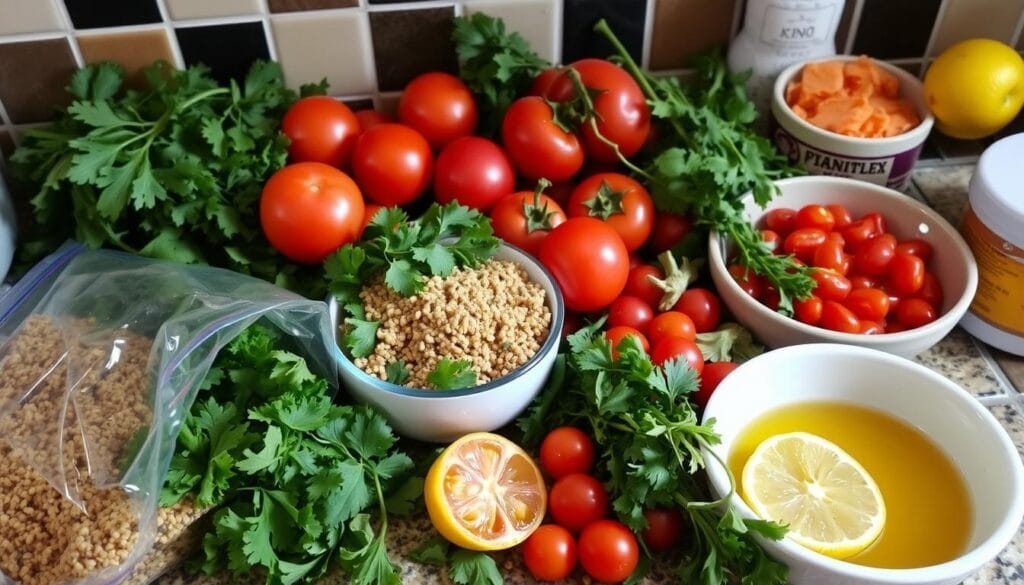
Making authentic Lebanese Tabouleh needs care and focus. Many people make big mistakes that can ruin the salad. Knowing these tips can make your salad prep look like a pro’s.
“Perfection in Tabouleh is about balance and technique” – Lebanese Culinary Tradition
Here are the top mistakes that can mess up your salad:
- Bulgur Blunder: Too much bulgur wheat messes up the parsley-to-grain ratio. Real Tabouleh should be mostly green, with just a bit of grain.
- Chopping Catastrophe: Bad chopping can ruin the salad’s feel. Parsley should be finely chopped for a light, fluffy texture.
- Dressing Disaster: Too much dressing can overwhelm the salad. Use olive oil and lemon lightly.
Using fresh ingredients is crucial for a great Tabouleh. Choose crisp parsley, ripe tomatoes, and top-notch olive oil. Make sure all ingredients are clean and well-prepared.
Timing is key in making Tabouleh. Mix everything just before serving to keep the texture right. If you’re making it ahead, keep the ingredients separate and mix them just before serving.
Conclusion
Your journey into Lebanese tabouleh is more than a salad. It opens the door to Mediterranean cuisine, turning simple ingredients into a healthy masterpiece. By learning to make fresh herb salads, you discover a world of flavors and health benefits.
This guide teaches you to make authentic tabouleh. It combines traditional cooking with modern healthy meal ideas. Each parsley leaf and bulgur wheat piece connects you to centuries of cooking tradition, bringing Lebanon’s flavors to your kitchen.
Adding tabouleh to your meals means embracing vibrant, healthy eating. This dish shows that healthy food can be delicious. It’s a mix of nutrition, culture, and creativity. Tabouleh is great as a side or a light lunch, showing the beauty of Mediterranean cooking.
Now, you’re ready to explore more. Try your own tabouleh recipes, trust your taste, and enjoy making a dish loved for generations in the Middle East.
FAQ
What is Lebanese Tabouleh?
Lebanese Tabouleh is a fresh salad from the Mediterranean. It’s made with chopped parsley, mint, tomatoes, onion, and bulgur wheat. It’s dressed with olive oil and lemon juice. This salad is a tasty and healthy start or side in Lebanese food.
Is Tabouleh gluten-free?
No, traditional Tabouleh has bulgur wheat, which has gluten. But, you can make a gluten-free version. Just use quinoa or a gluten-free grain instead of bulgur.
How long can Tabouleh be stored?
You can keep Tabouleh in the fridge for 2-3 days in an airtight container. For the best taste and texture, eat it within 24 hours.
What type of parsley is best for Tabouleh?
Flat-leaf parsley is the best choice for Lebanese Tabouleh. It tastes better and has a nicer texture than curly parsley.
Can Tabouleh be a main course?
Yes, you can make Tabouleh a main dish. Just add protein like grilled chicken, chickpeas, or feta cheese to make it more filling.
Is Tabouleh considered healthy?
Absolutely, Tabouleh is very healthy. It’s full of fresh herbs, veggies, and whole grains. It’s low in calories and fits well with the Mediterranean diet.
How fine should the parsley be chopped?
For real Tabouleh, chop the parsley very finely. Almost mince it. This makes the herbs mix well with other ingredients.
What’s the difference between Lebanese and Syrian Tabouleh?
Lebanese Tabouleh has more herbs and less bulgur. Syrian versions have more bulgur and fewer herbs.
Can I make Tabouleh in advance?
You can prep Tabouleh parts ahead of time. But, mix everything just before serving. This keeps it fresh and prevents it from getting watery.
What are traditional Tabouleh accompaniments?
Traditionally, Tabouleh goes with pita bread, in mezze platters, or with grilled meats. It’s also great with hummus, baba ganoush, and other Middle Eastern starters.
